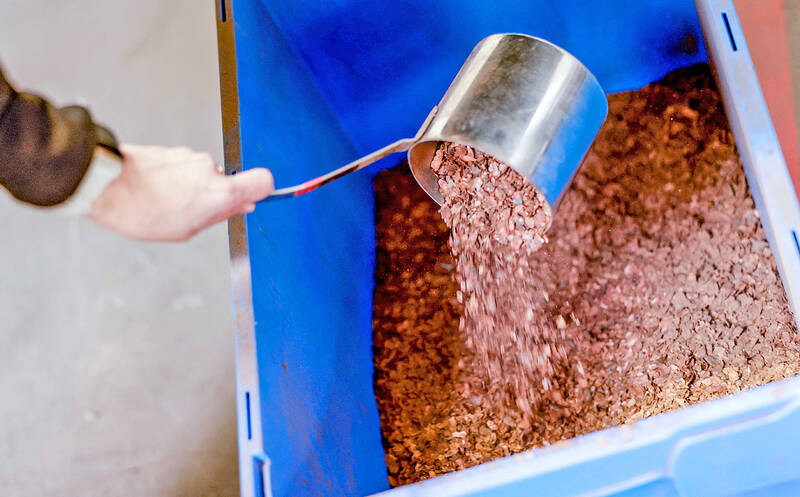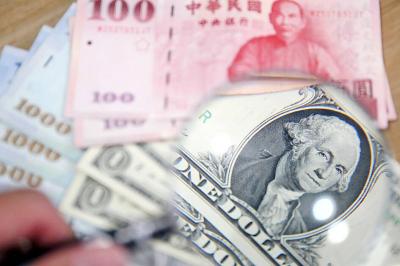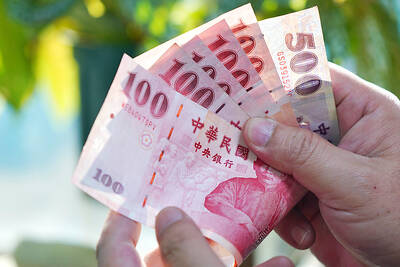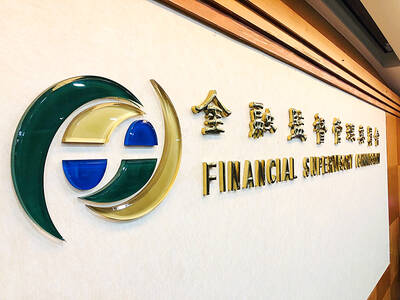At a red-brick factory in the German port city of Hamburg, cocoa bean shells go in one end and out the other comes an amazing black powder with the potential to counter climate change.
The substance, dubbed biochar, is produced by heating the cocoa husks in an oxygen-free room to 600°C.
The process locks in greenhouse gases and the final product can be used as a fertilizer, or as an ingredient in the production of “green” concrete.

Photo: AFP
While the biochar industry is still in its infancy, the technology offers a novel way to remove carbon from the Earth’s atmosphere, experts have said.
Biochar could potentially be used to capture 2.6 billion of the 40 billion tonnes of carbon dioxide produced by humans each year, the UN’s Intergovernmental Panel on Climate Change (IPCC) said.
However, scaling up its use remains a challenge.
“We are reversing the carbon cycle,” Circular Carbon chief executive officer Peik Stenlund told reporters at the biochar factory in Hamburg.
The plant, one of the largest in Europe, takes delivery of the used cocoa shells via a network of gray pipes from a neighboring chocolate factory.
The biochar traps the carbon dioxide contained in the husks — in a process that could be used for any other plant.
If the cocoa shells were disposed of as normal, the carbon inside the unused byproduct would be released into the atmosphere as it decomposed.
Instead, the carbon is sequestered in the biochar “for centuries,” said David Houben, an environmental scientist at the UniLaSalle Institute in France.
One tonne of biochar — or bio coal — can stock “the equivalent of 2.5 to 3 tonnes of CO2,” Houben told reporters.
Biochar was already used by indigenous populations in the Americas as a fertilizer before being rediscovered in the 20th century by scientists researching extremely fecund soils in the Amazon basin.
The surprising substance’s sponge-like structure boosts crops by increasing the absorption of water and nutrients by the soil.
In Hamburg, the factory is wrapped in the faint smell of chocolate and warmed by the heat given off by the installation’s pipework.
The final product is poured into white sacks to be sold to local farmers in granule form.
The production process, called pyrolysis, also produces biogas, which is resold to the neighboring factory. In all, 3,500 tonnes of biochar and “up to 20 megawatt-hours” of gas are produced by the plant each year from 10,000 tonnes of cocoa shells, the plant said.
The production method remains difficult to scale up to the level imagined by the IPCC.
“To ensure the system stores more carbon than it produces, everything needs to be done locally, with little or no transport. Otherwise it makes no sense,” Houben said.
Not all types of soil are well-adapted to biochar.
The fertilizer is “more effective in tropical climates,” while the raw materials for its production are not available everywhere, Houben said.
The cost can also be prohibitive at "around 1,000 euros [US$1,072] a tonne — that's too much for a farmer," he added.
To make better use of the powerful black powder, Houben said other applications would need to be found.
The construction sector, for example, could use biochar in the production of "green" concrete.
However, to turn a profit, the biochar business has come up with another idea: selling carbon certificates.
The idea is to sell certificates to companies looking to balance out their carbon emissions by producing a given amount of biochar.
With the inclusion of biochar in the highly regulated European carbon certificates system, "we are seeing strong growth in [the] sector," Stenlund said.
His company is looking to open three new sites to produce more biochar in the coming months.

The US dollar was trading at NT$29.7 at 10am today on the Taipei Foreign Exchange, as the New Taiwan dollar gained NT$1.364 from the previous close last week. The NT dollar continued to rise today, after surging 3.07 percent on Friday. After opening at NT$30.91, the NT dollar gained more than NT$1 in just 15 minutes, briefly passing the NT$30 mark. Before the US Department of the Treasury's semi-annual currency report came out, expectations that the NT dollar would keep rising were already building. The NT dollar on Friday closed at NT$31.064, up by NT$0.953 — a 3.07 percent single-day gain. Today,

‘SHORT TERM’: The local currency would likely remain strong in the near term, driven by anticipated US trade pressure, capital inflows and expectations of a US Fed rate cut The US dollar is expected to fall below NT$30 in the near term, as traders anticipate increased pressure from Washington for Taiwan to allow the New Taiwan dollar to appreciate, Cathay United Bank (國泰世華銀行) chief economist Lin Chi-chao (林啟超) said. Following a sharp drop in the greenback against the NT dollar on Friday, Lin told the Central News Agency that the local currency is likely to remain strong in the short term, driven in part by market psychology surrounding anticipated US policy pressure. On Friday, the US dollar fell NT$0.953, or 3.07 percent, closing at NT$31.064 — its lowest level since Jan.

The New Taiwan dollar and Taiwanese stocks surged on signs that trade tensions between the world’s top two economies might start easing and as US tech earnings boosted the outlook of the nation’s semiconductor exports. The NT dollar strengthened as much as 3.8 percent versus the US dollar to 30.815, the biggest intraday gain since January 2011, closing at NT$31.064. The benchmark TAIEX jumped 2.73 percent to outperform the region’s equity gauges. Outlook for global trade improved after China said it is assessing possible trade talks with the US, providing a boost for the nation’s currency and shares. As the NT dollar

The Financial Supervisory Commission (FSC) yesterday met with some of the nation’s largest insurance companies as a skyrocketing New Taiwan dollar piles pressure on their hundreds of billions of dollars in US bond investments. The commission has asked some life insurance firms, among the biggest Asian holders of US debt, to discuss how the rapidly strengthening NT dollar has impacted their operations, people familiar with the matter said. The meeting took place as the NT dollar jumped as much as 5 percent yesterday, its biggest intraday gain in more than three decades. The local currency surged as exporters rushed to